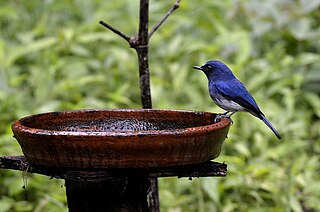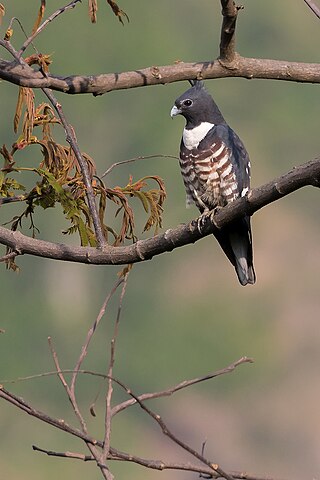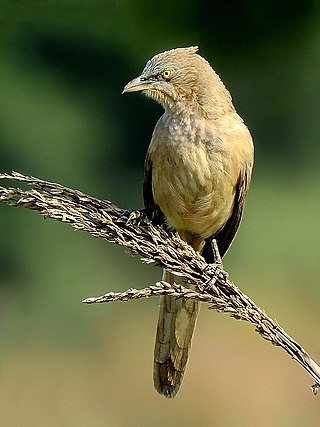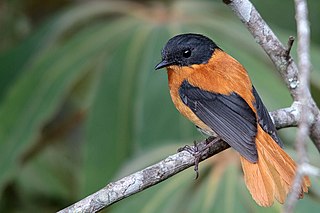
The Malabar trogon is a species of bird in the trogon family. It is found in the forests of India and Sri Lanka. In India it is mainly found in the Western Ghats, hill forests of central India and in parts of the Eastern Ghats. They are insectivorous and although not migratory, may move seasonally in response to rain in hill forest regions. Like in other trogons, males and females vary in plumage. The birds utter low guttural calls that can be heard only at close quarters and the birds perch still on a branch under the forest canopy, often facing away from the viewer making them easy to miss despite their colourful plumage.

The Indian white-eye, formerly the Oriental white-eye, is a small species of passerine bird in the white-eye family. It is a resident breeder in open woodland on the Indian subcontinent. They forage in small groups, feeding on nectar and small insects. They are easily identified by the distinctive white eye-ring and overall yellowish upperparts. The range previously extended eastwards to Southeast Asia, Indonesia and Malaysia. Their name was recently changed due to previous members of Zosterops palpebrosus in Southeast Asia being renamed to a new species, making the Indian White-eye a more geographically accurate term for this species.

The Malabar whistling thrush is a whistling thrush in the family Muscicapidae. The bird has been called whistling schoolboy for the whistling calls that they make at dawn that have a very human quality. The species is a resident in the Western Ghats and associated hills of peninsular India including central India and parts of the Eastern Ghats.

The pied thrush is a member of the thrush family found in India and Sri Lanka. The males are conspicuously patterned in black and white while the females are olive brown and speckled. They breed in the central Himalayan forests and winter in the hill forests of southern India and Sri Lanka. Like many other thrushes, they forage on leaf litter below forest undergrowth and fly into trees when disturbed and sit still making them difficult to locate.

The purple sunbird is a small bird in the sunbird family found mainly in South and Southeast Asia but extending west into parts of the Arabian peninsula. Like other sunbirds they feed mainly on nectar, although they will also take insects, especially when feeding young. They have a fast and direct flight and can take nectar by hovering like a hummingbird but often perch at the base of flowers. The males can appear all black in harsh sunlight but the purple iridescence is visible on closer observation or under good light conditions. Females are olive above and yellowish below.

The Indian scimitar babbler is an Old World babbler. It is found in peninsular India in a range of forest habitats. They are most often detected by their distinctive calls, which include an antiphonal duet by a pair of birds. They are often hard to see as they forage through dense vegetation. The long, curved yellow, scimitar-shaped bills give them their name. It has been treated in the past as a subspecies of the white-browed scimitar babbler which is found along the Himalayas but now separated into two species, the peninsular Indian species and the Sri Lanka scimitar babbler.

The white-bellied blue flycatcher is a small passerine bird in the flycatcher family Muscicapidae. It is endemic to the Western Ghats of southwest India. Males are dark blue with a lighter shade of blue on the brow and have a greyish white belly. Females have a rufous breast, a white face and olive grey above.

The Indian blue robin is a small bird found in the Indian Subcontinent. Formerly considered a thrush, it is now considered one of the Old World flycatchers in the family Muscicapidae. It was earlier also called the Indian blue chat. It is migratory, breeding in the forests along the Himalayas of Nepal, India, Myanmar and Bangladesh. They winter in the hill forests of the Western Ghats of India and in Sri Lanka.

The blue-winged parakeet, also known as the Malabar parakeet is a species of parakeet endemic to the Western Ghats of southern India. Found in small flocks, they fly rapidly in forest clearings while making screeching calls that differ from those of other parakeet species within their distribution range. Their long blue tails tipped in yellow and the dark wings with blue contrast with the dull grey of their head and body. Adult males and females can be easily told apart from the colour of their beak.

The pale-billed flowerpecker or Tickell's flowerpecker is a tiny bird that feeds on nectar and berries, found in India, Sri Lanka, Bangladesh and western Myanmar. The bird is common especially in urban gardens with berry bearing trees. They have a rapid chipping call and the pinkish curved beak separates it from other species in the region.

Nandi Hills is an ancient hill station built by Ganga Dynasty in the Chikkaballapur district of Karnataka state. It is 10 km from Chickballapur town and approximately 60 km from Bengaluru. The hills are near the town Nandi. In traditional belief, the hills are the origin of the Arkavathy river, Ponnaiyar River, Palar River, Papagni River and Penna River. Watching the sunrise at Nandi Hills is popular with tourists. The first ever SAARC summit hosted by India was held at Nandi Hills in 1986.

The blue-bearded bee-eater is a species of bee-eater found in much of the Indian subcontinent and parts of Southeast Asia. This bee-eater is found in forest clearings. It is found mainly in the Malayan region but extends west into peninsular India. The blue feathers of its throat are elongated and often fluffed giving it its name. They have a loud call but are not as gregarious or active as the smaller bee-eaters, and their square ended tail lacks the typical "wires" made up of the shafts of the longer central tail feathers found in many other bee-eaters.

The yellow-throated bulbul is a species of songbird in the bulbul family of passerine birds. The species is endemic to southern peninsular India. They are found on scrub habitats on steep, rocky hills many of which are threatened by granite quarrying. It is confusable only with the white-browed bulbul with which its range overlaps but is distinctively yellow on the head and throat apart from the yellow vent. The calls of this species are very similar to that of the white-browed bulbul.

The painted bush quail is a species of quail found in the hill forests of India. They move in small coveys on hillsides and are distinguished by their red bills and legs. They have a liquid alarm call and small groups will run in single file along paths before taking flight when flushed.

The black baza is a small bird of prey found in the forests of Northeast India, the eastern Himalayas, China and Southeast Asia. Many populations are migratory, including those in the Indian region, which winter in the south of the Peninsula and Sri Lanka. Black bazas have short, stout legs and feet with strong talons, and a prominent crest. They are found in dense forest, often in small groups, and can often be found perched on bare branches of tall trees rising above the forest canopy.

The large gray babbler is a member of the family Leiothrichidae found across India and far western Nepal. They are locally common in the scrub, open forest and gardenland. They are usually seen in small groups and are easily distinguished from other babblers in the region by their nasal call and the whitish outer feathers to their long tail. It is one of the largest babblers in the region.

The black-and-orange flycatcher or black-and-rufous flycatcher is a species of flycatcher endemic to the central and southern Western Ghats, the Nilgiris and Palni hill ranges in southern India. It is unique among the Ficedula flycatchers in having rufous coloration on its back and prior to molecular studies was suggested to be related to the chats and thrushes.

The pale-capped pigeon, also known as the purple wood pigeon, is a species of large pigeon that is found patchily distributed in parts of the Indian subcontinent and Southeast Asia. It has a slow flight and spends a lot of time sitting still in the foliage of large fruiting trees, often in riverine forest on the plains. It is mainly brown above and chestnut below with the a sheen of green or amethyst. Males have a whitish grey cap while females have a brownish grey cap and less gloss on the feathers. They are frugivores, foraging in small groups in the canopy of trees but sometimes descending to the ground for seeds and fallen fruit.

The Indian blackbird is a member of the thrush family Turdidae. It was formerly considered a subspecies of the common blackbird. It is found only in India and Sri Lanka. The subspecies from most of the Indian subcontinent, simillimus, nigropileus, bourdilloni and spencei, are small, only 19–20 centimetres long, and have broad eye-rings. They also differ in proportions, wing formula, egg colour and voice from the common blackbird.
Wood pigeon, wood-pigeon or woodpigeon may refer to:























